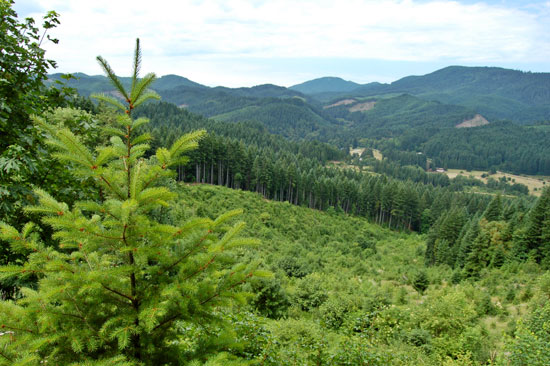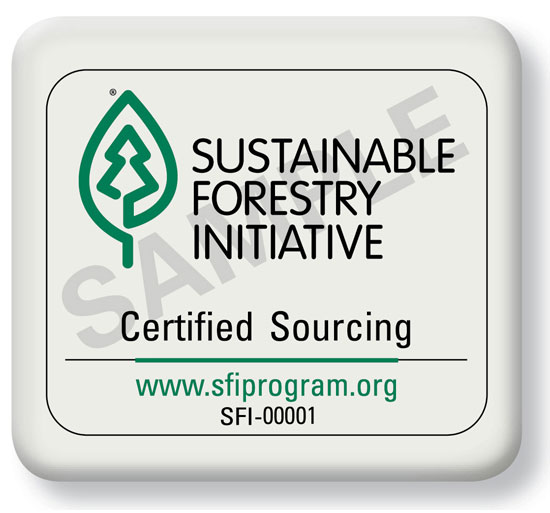Sustainable Building with SFI Certified Wood
SFI 2010-2014: Fiber Sourcing
All forest landowners play a critical role in ensuring the long-term health and sustainability of forests. In North America, this includes millions of family-owned forests. SFI supports and promotes responsible forest management on both certified and uncertified lands in North America through its fiber sourcing requirements.
Through its fiber-sourcing program, SFI helps educate small family forest landowners about the benefits of sustainable forestry. SFI Program Participants are expected to educate owners of non-certified North American forests, from whom they procure materials, about proper and responsible logging practices, sustainable land use and reforestation, the protection of critical habitats and water bodies, and the economic and environmental threats posed by illegal logging activities.
 |
Multi-aged stand on Starker Forest land outside of Philomath, Oregon Photo courtesy of Jordan Benner |
When SFI Program Participants source fiber from jurisdictions outside of North America, they must complete a risk assessment to avoid illegal sources of supply, and they must promote the conservation of biodiversity hotspots and high-biodiversity wilderness areas. However, one advantage of using SFI-certified materials is that 98 percent of the fiber sourced by SFI Program Participants for their North American facilities comes from the U.S. and Canada. To comply with the Standard's requirements for fiber sourcing, Program Participants must meet the requirements of 13 SFI program objectives, 22 performance measures, and 56 indicators. The SFI fiber sourcing objectives are:
 |
Since 1995, SFI Program Participants have invested nearly $1.4 billion in research on forestry issues. Photo courtesy of Phil Riebel |
Landowner Outreach
To broaden the practice of sustainable forestry by forest landowners through fiber sourcing programs.
Use of Qualified Resource and Qualified Logging Professionals
Broaden the practice of sustainable forestry by encouraging forest landowners to utilize the services of forest management and harvesting professionals.
Adherence to Best Management Practices
Broaden the practice of sustainable forestry through the use of best management practices to protect water quality.
Promote Conservation of Biological Diversity, Biodiversity Hotspots, and High-Biodiversity Wilderness Areas
Broaden the practice of sustainable forestry by conserving biological diversity, biodiversity hotspots, and high-biodiversity wilderness areas.
Avoidance of Controversial Sources including Illegal Logging
Broaden the practice of sustainable forestry by avoidance of illegal logging.
Avoidance of Controversial Sources including Fiber Sourced from Areas without Effective Social Laws
Broaden the practice of sustainable forestry by avoiding controversial sources.
Legal and Regulatory Compliance
Compliance with applicable federal, provincial, state and local laws and regulations.
Forestry Research, Science, and Technology
To support forestry research, science, and technology, upon which sustainable forest management decisions are based.
Training and Education
To improve the implementation of sustainable forestry practices through appropriate training and education programs.
Community Involvement in the Practice of Sustainable Forestry
To broaden the practice of sustainable forestry by encouraging the public and forestry community to participate in the commitment to sustainable forestry, and publicly report progress.
Public Land Management Responsibilities
To support and implement sustainable forest management on public lands.
Communications and Public Reporting
To broaden the practice of sustainable forestry by documenting progress and opportunities for improvement.
Management Review and Continual Improvement
To promote continual improvement in the practice of sustainable forestry, and to monitor, measure, and report performance in achieving the commitment to sustainable forestry.
Any company that is certified to meet the Standard's fiber sourcing requirements can use SFI's Certified Sourcing Label. The SFI certified sourcing label and claim do not make claims about certified forest content. Certified sourcing can include fiber sourced from a company that conforms with objectives 8-20 of Section 2 - SFI 2010-2014 Standard's fiber sourcing requirements, from pre- or post-consumer recycled content, or from a certified forest, and fiber sourced from non-controversial sources.
 |









